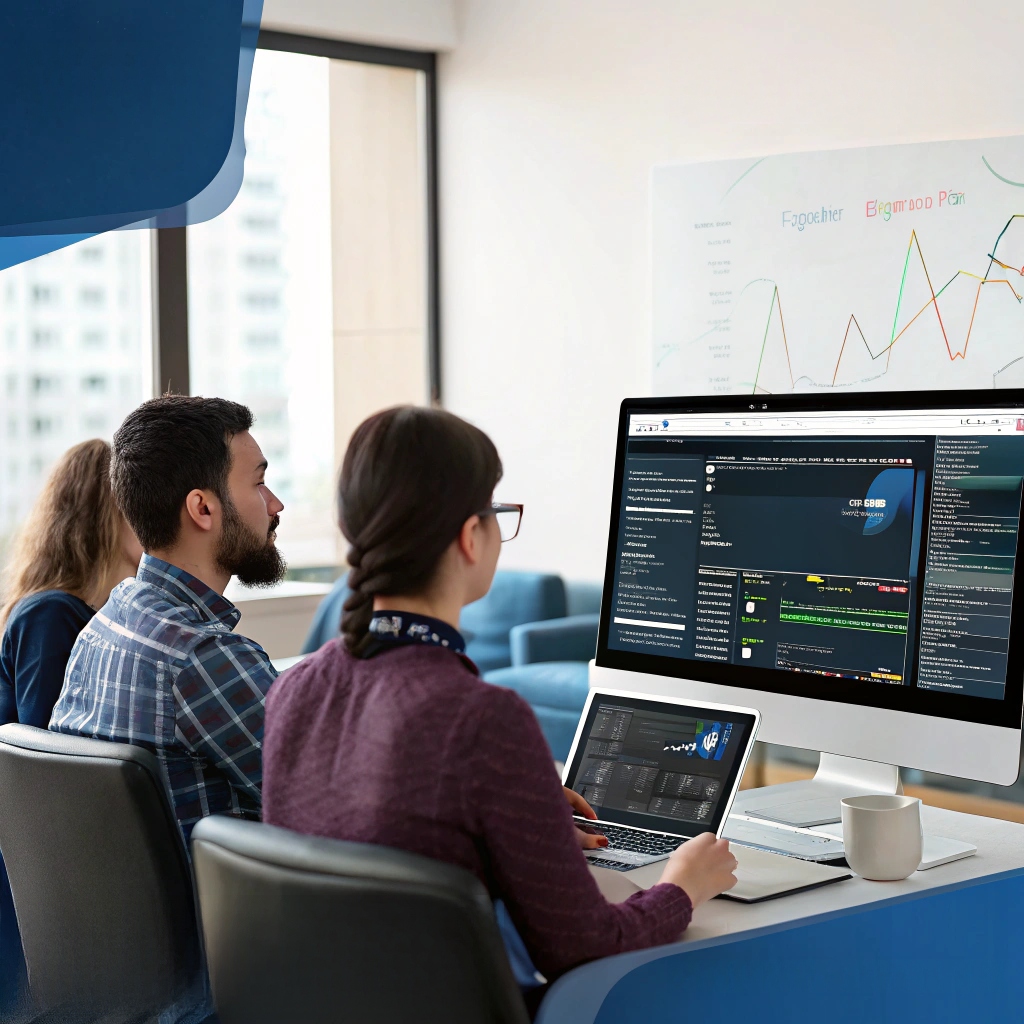Feeling lost in a sea of algorithms and technical jargon when it comes to Search Engine Optimization?
Let’s be honest – SEO can seem incredibly complex. You’ve probably spent hours researching keywords, building backlinks, and tweaking content, only to see little to no results. It’s frustrating, confusing, and frankly, expensive!
Imagine confidently Guiding the intricacies of Google’s ranking factors, driving targeted traffic directly to your website, and seeing tangible growth in your online visibility.
That’s exactly what you’ll discover with Saadqain.com Training – a pathway to mastering technical SEO that’s clear, effective, and delivers real results.
Decoding the Digital Landscape
Feeling lost in a sea of SEO jargon? It’s easy to get overwhelmed by all the buzzwords – backlinks, keyword density, algorithm updates… but honestly, it doesn’t have to be this complicated.
Spending hours trying to decipher every Google update without truly understanding things change is a massive time sink and often leaves you chasing shadows.
Imagine knowing exactly what search engines prioritize and building your website around those signals – that’s the difference between struggling for visibility and attracting organic traffic consistently.
Saadqain.com Training cuts through the noise, delivering a clear, actionable roadmap to mastering technical SEO.
Every moment wasted on guesswork is a missed opportunity to optimize your site for genuine search engine results.
The truth is, technical SEO isn’t about complicated formulas; it’s about understanding how search engines work – and that’s exactly what Saadqain.com Training reveals.
Let’s dive into the strategies that will transform your website from a ghost in the digital world to a powerful, visible asset.
Keyword Research – Beyond Basics
What makes keyword research truly effective goes far beyond simply finding popular terms. It’s about understanding *why* those terms are popular and how you can genuinely rank for them.
Let’s talk about search intent— it’s the underlying reason someone is searching. Are they looking to buy something? Learn about a topic? Find directions? Recognizing this intent shapes your entire strategy.
For example, “running shoes” is broad. But if you dig deeper and see that many people are searching for “best running shoes for flat feet,” you’ve identified a more specific need—and a better opportunity.
You also need to consider long-tail keywords – these are longer, more detailed phrases that often have less competition. They show a very clear intention and can drive highly qualified traffic.
Instead of “coffee,” try “best organic fair trade coffee beans online.” You’re targeting someone specifically looking for those qualities, increasing the chances they’ll convert.
So, really digging into search intent and exploring long-tail keywords— that’s what elevates your keyword research from basic to truly strategic.
Technical Audits – Unmasking Problems
 During a technical SEO audit, problems often hide beneath the surface.
During a technical SEO audit, problems often hide beneath the surface.
This is because many website issues aren’t immediately obvious—they can be buried within code, server configurations, or even just poor implementation of best practices.
Think about things like broken links that aren’t easily spotted through a simple manual check, or duplicate content subtly present across multiple pages. These issues can significantly impact search engine rankings without you realizing the full extent of the damage.
That’s where expert technical SEO training comes in – it helps you unmask these hidden problems and optimize your website for peak performance.
Saadqain.com offers comprehensive courses that cover everything from site speed optimization and mobile-friendliness to schema markup implementation and crawl errors. Learning how to analyze Google Search Console data, using tools like Screaming Frog, and understanding core web vitals will empower you to identify and fix these technical issues effectively.
By investing in this type of training, you gain the knowledge and skills needed to proactively maintain a technically sound website, boosting your organic visibility and driving more qualified traffic.
Site Architecture – User Flow Mastery
As a cornerstone of technical SEO, understanding site architecture is absolutely crucial. It’s about designing your website so that search engines—and your users—can easily navigate and find what they’re looking for.
Think about it this way: user flow is the journey someone takes on your site to achieve a goal – whether that’s finding information, making a purchase, or simply exploring. A well-designed architecture makes that journey smooth and intuitive.
A clear hierarchy—with key pages easily accessible from the homepage—is essential. If users can’t quickly find what they need, they’ll bounce, hurting your search rankings. Proper internal linking helps guide them through relevant content.
User flow mastery means optimizing for how people naturally browse and interact with a website. This includes things like category structures, breadcrumb navigation, and sitemaps.
A well-organized site map makes it easier for search engines to crawl and index your content effectively – boosting visibility. A logical flow encourages users to explore more pages on the same domain, increasing time on site—a positive ranking factor.
Ultimately, mastering site architecture and user flow creates a seamless experience that benefits both search engines and your audience. It’s about building a robust foundation for long-term SEO success.
Mobile Optimization – The Mobile Shift
If mobile optimization is a key part of your SEO strategy, it’s absolutely vital you understand its importance. It’s not just about having a website that *looks* okay on a phone; it’s about fundamentally changing how search engines – and potential customers – interact with your content.
Mobile-first indexing means Google primarily uses the mobile version of a site for ranking and indexing. So, if your desktop site isn’t optimized, you’re missing out on huge opportunities!
Think about it: most people browse the internet using their smartphones. If your website isn’t designed with this user in mind, you’ll be at a serious disadvantage. Ensuring fast loading speeds is key – slow mobile sites get penalized.
Responsive design is absolutely crucial—it adapts to any screen size seamlessly. This ensures a consistent experience for everyone, regardless of how they’re accessing your site.
This means testing your website on various devices (phones, tablets) and making sure everything – images, text, navigation – looks great and functions properly. It’s about providing an intuitive user journey.
Essentially, mastering mobile optimization is no longer optional; it’s the foundation of a successful SEO strategy in today’s digital landscape.
Core Web Vitals – Speed & Quality
Just think about how important a fast website is for your visitors. You want them to be able to quickly find what they’re looking for, right? That’s where Core Web Vitals come in – they measure exactly how speedy and high-quality your site is.
Let’s talk about ‘Speed’. Google really cares about this! They use Core Web Vitals to see if your website loads quickly enough. Things like page load time, First Contentful Paint, and Largest Contentful Paint all play a part here. A slow website can frustrate visitors and send them running to a competitor – and that hurts your search rankings.
Optimizing images, using efficient code, and choosing a good web host are all things you can do to improve your site’s speed. It’s about making sure everything loads as quickly as possible for the person viewing it.
Now let’s consider ‘Quality’. This is measured by things like First Input Delay and Cumulative Layout Shift. Basically, this looks at how smoothly users can interact with your site – are buttons responding instantly? Is content shifting around unexpectedly while they’re trying to click something? A poor quality experience leads to frustrated visitors and a negative impression of your brand.
Making sure your website is responsive (works well on all devices), using CSS effectively, and testing regularly can help you improve this aspect of Core Web Vitals.
Indexing & Crawling – Getting Found
 Now, let’s talk about how indexing and crawling work together—it’s really key to getting your website found. Think of search engines like Google as constantly exploring the internet, looking for information.
Now, let’s talk about how indexing and crawling work together—it’s really key to getting your website found. Think of search engines like Google as constantly exploring the internet, looking for information.
Crawling is when these search engine bots – they’re called “crawlers” or “spiders”—follow links from one page to another, discovering new content and building a map of the web. It’s like them tracing connections!
The more links pointing *to* your website, the easier it is for these crawlers to find you. And the more pages they can crawl on *your* site, the better.
Indexing then takes place—search engines analyze all that information and add it to their index – a massive database of web content.
It’s like creating an enormous library catalog! When someone searches for something, Google uses its index to quickly find the most relevant pages.
So, crawling is *finding* the content, and indexing is *organizing* it so search engines can easily locate and understand it—that’s how you get found!
Schema Markup – Enriching Search Data
The key to understanding schema markup is recognizing that search engines like Google don’t always fully grasp the *meaning* behind your website content. They see words, but they don’t inherently understand what those words represent.
Schema markup acts as a layer of code you add to your website – think of it like extra instructions for Google. It clarifies exactly what your page is about—is it a recipe? A hotel? An event?
For example, if you have a blog post about a restaurant, schema markup can tell Google that the post is a “Restaurant” and provide details such as its address, phone number, hours of operation, and cuisine type. You could also add information about reviews or menu items.
This level of detail helps search engines to understand your content far more accurately. And this understanding directly impacts how Google displays your website in search results – it can lead to rich snippets!
Rich snippets are those visually enhanced results you see with star ratings, prices, or event dates. They make your listing stand out and encourage clicks from users searching for that information.
Essentially, schema markup helps you “speak the language” of search engines, ensuring they fully understand what your website offers – boosting its visibility and attracting more organic traffic.
Link Building – Strategic Relationships
With strategic relationships forming the backbone of link building, it’s about fostering genuine connections. It’s not just about getting links; it’s about earning them through valuable content and mutual support.
Think of outreach as a conversation, not a transaction. Building strong relationships with other website owners can create opportunities for reciprocal linking.
If you create amazing content – let’s say a detailed guide on sustainable fashion – reaching out to bloggers and websites in that niche demonstrates your expertise and opens the door for them to link back to your site, and vice versa. It’s about providing value first.
The best relationships are built through consistent engagement—sharing their content, commenting thoughtfully, and participating in relevant communities.
For example, if you’re passionate about digital marketing, engaging with influencers who share that passion can lead to collaborations and links down the line. It’s a long-term strategy focused on building trust.
Ultimately, link building through strategic relationships is an investment in your website’s authority – a network of supportive connections that will benefit you for years to come.
Content Optimization – Relevance is Key
During content optimization, relevance truly is key. You need to ensure that every piece of content you create speaks directly to what your audience is searching for. It’s not enough just to have great writing; it has to be *relevant*.
Think about how search engines work – they analyze keywords and phrases. If your page doesn’t contain those exact terms, or closely related ones, you’re going to struggle to rank well. You need to understand what people are actually typing into Google when looking for information like yours.
For example, if you’re writing about “best running shoes,” don’t just talk about running in general. You have to use that specific keyword – and variations of it – throughout your content. The more naturally it appears, the better. It’s also important to consider long-tail keywords – these are longer, more specific phrases that people might search for (e.g., “best running shoes for flat feet”).
Relevance isn’t just about keyword stuffing – using a word repeatedly just to rank higher. That can actually hurt you! It’s about genuinely addressing the topic and providing valuable information that satisfies the user’s search intent. You need to answer their question, solve their problem, or fulfill their desire.
Analytics & Tracking – Data Driven
It’s like understanding a website’s performance is only half the battle. To truly master Technical SEO, you need to know *how* to measure it.
Analytics & Tracking – Data Driven means diving deep into your site’s metrics. This isn’t just about seeing that traffic numbers have increased; it’s about understanding *why*.
Think of Google Search Console as your first stop. It shows you exactly which keywords are sending you traffic, where those visitors are coming from (organic, paid, referral), and any technical errors hindering your site’s performance – like broken links or indexing problems.
Then there’s Google Analytics—it provides a broader picture. You can track user behavior: how long they spend on pages, which sections they explore, and where they exit your site. This data tells you if content is engaging or confusing.
Using tools like heatmaps and scroll maps allows you to see exactly what users are focusing on – and what they’re missing! It’s about identifying areas for improvement based on real user behavior, not just assumptions.
So mastering Technical SEO isn’t just about fixing robots.txt files or optimizing meta descriptions; it’s about consistently monitoring your data and using those insights to drive continuous optimization – making sure that every change you make is backed up by solid evidence.
Google Search Console – Your Insights
What makes Google Search Console so valuable is that it’s like a direct line to how Google *sees* your website. It shows you exactly what search queries are bringing people to your site – even if they don’t match the keywords you’re targeting.
Think of it as a report card for your site, detailing its performance in the eyes of the world’s biggest search engine. You can see which searches resulted in impressions (meaning someone saw your site) and clicks.
This helps you understand if people are searching for something related to your business but using different terms. Maybe they’re typing “best pizza near me” instead of “pizza delivery.”
The insights within Search Console also reveal which pages are performing well and which aren’t. You can see the click-through rate – how often people who find your site on Google actually click through to view that specific page.
This allows you to quickly identify content that needs improvement or optimization. Perhaps a particular page has a low click-through rate, suggesting it’s not compelling enough to entice users to stay and explore.
Essentially, Google Search Console gives you the data *you* need to make informed decisions about your SEO strategy – directly from the source. It’s like having an insider’s view of how your website is performing in search results.
Saadqain.com’s Approach – Expert Guidance
 Every expert tutor at Saadqain.com is dedicated to giving you a solid understanding of technical SEO. You will receive personalized attention tailored to your specific needs and goals.
Every expert tutor at Saadqain.com is dedicated to giving you a solid understanding of technical SEO. You will receive personalized attention tailored to your specific needs and goals.
The core approach centers around hands-on learning – you’ll be actively involved in real-world scenarios, not just passively listening to lectures.
Imagine this: Instead of simply reading about keyword research, you’ll actually conduct it on a live website, guided step-by-step by your tutor. Or perhaps analyzing competitor websites and identifying opportunities for improvement.
You will also benefit from one-on-one sessions – allowing you to ask questions and receive immediate feedback as you learn. This ensures that concepts are fully grasped before moving on.
Ultimately, Saadqain.com’s approach is about empowering *you* with the knowledge and skills needed to confidently tackle any technical SEO challenge.
Unlock Hidden Potential: Turn Website Traffic into Revenue
A powerful online presence doesn’t happen by accident; it requires strategic knowledge and targeted expertise.
Many businesses struggle to truly understand the intricacies of technical SEO – things like site speed, mobile optimization, schema markup, and crawlability. These elements are absolutely crucial for search engines to recognize and rank a website effectively. Saadqain.com training provides access to experienced tutors who specialize in these very areas, offering personalized guidance and actionable strategies. It’s about going beyond the basics and building a foundation for sustainable growth.
Investing in expert technical SEO training can dramatically improve search engine rankings, driving more organic traffic – and ultimately, more qualified leads – to your business. A well-optimized website is a magnet for potential customers actively searching for what you offer. Furthermore, the tailored support available through Saadqain.com ensures that complex concepts are clearly explained and implemented efficiently.
Don’t let technical SEO remain a frustrating mystery. Explore the transformative power of Saadqain.com training today and watch your website climb the search results, attracting a steady stream of customers eager to engage with your brand.

